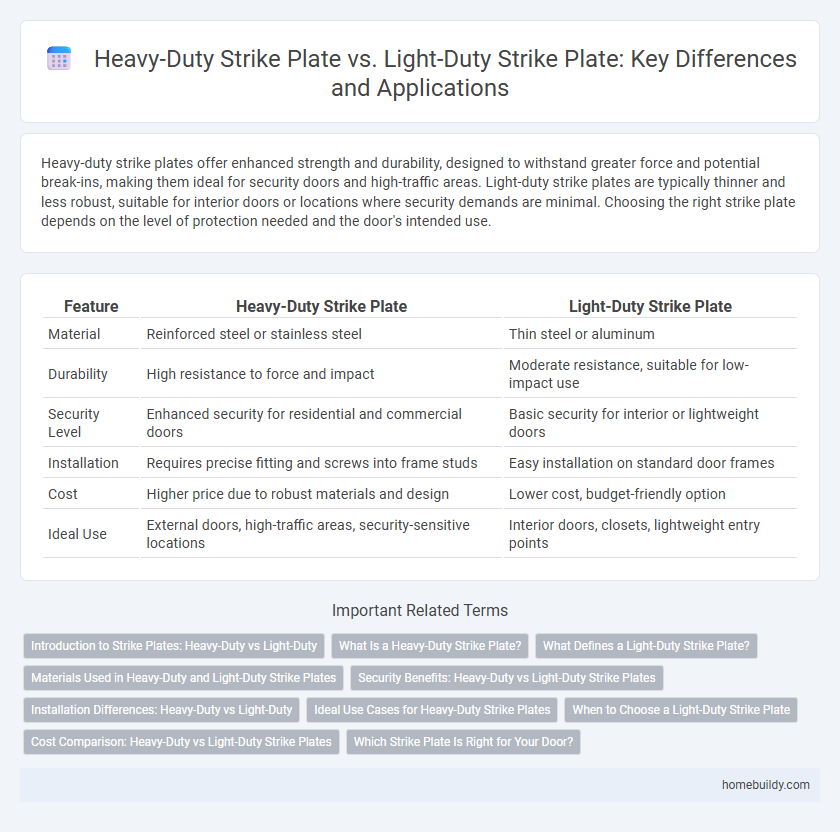Heavy-duty strike plates offer enhanced strength and durability, designed to withstand greater force and potential break-ins, making them ideal for security doors and high-traffic areas. Light-duty strike plates are typically thinner and less robust, suitable for interior doors or locations where security demands are minimal. Choosing the right strike plate depends on the level of protection needed and the door's intended use.
Table of Comparison
| Feature | Heavy-Duty Strike Plate | Light-Duty Strike Plate |
|---|---|---|
| Material | Reinforced steel or stainless steel | Thin steel or aluminum |
| Durability | High resistance to force and impact | Moderate resistance, suitable for low-impact use |
| Security Level | Enhanced security for residential and commercial doors | Basic security for interior or lightweight doors |
| Installation | Requires precise fitting and screws into frame studs | Easy installation on standard door frames |
| Cost | Higher price due to robust materials and design | Lower cost, budget-friendly option |
| Ideal Use | External doors, high-traffic areas, security-sensitive locations | Interior doors, closets, lightweight entry points |
Introduction to Strike Plates: Heavy-Duty vs Light-Duty
Heavy-duty strike plates are engineered from robust materials like hardened steel to withstand significant force, making them ideal for high-security doors and commercial applications. Light-duty strike plates, usually made from thinner metal, are suitable for interior doors or areas with minimal security concerns. Choosing the appropriate strike plate enhances door frame reinforcement and impacts overall lock durability and protection.
What Is a Heavy-Duty Strike Plate?
A heavy-duty strike plate is a reinforced metal plate designed to withstand high levels of force and prevent door frame damage during forced entry attempts. Unlike light-duty strike plates, which are typically thinner and used for interior doors, heavy-duty strike plates feature thicker gauge steel and longer mounting screws that anchor firmly into the door frame studs. This enhanced durability provides superior security for exterior doors, making them essential components in residential and commercial security systems.
What Defines a Light-Duty Strike Plate?
A light-duty strike plate is defined by its thinner gauge steel construction, typically less than 14-gauge, designed for residential doors with standard latch bolts and light traffic. It offers basic protection by reinforcing the door frame against minor impacts but lacks the robust resistance against forced entry compared to heavy-duty strike plates. Commonly installed in interior or low-security exterior doors, light-duty strike plates prioritize ease of installation and cost-effectiveness over maximum security.
Materials Used in Heavy-Duty and Light-Duty Strike Plates
Heavy-duty strike plates are typically crafted from solid steel or reinforced stainless steel, providing superior strength and resistance to forced entry compared to light-duty strike plates, which are often made from thinner galvanized steel or zinc alloys. The thicker gauge and robust materials in heavy-duty plates enhance durability and security, making them suitable for high-traffic or high-risk environments. Light-duty strike plates offer sufficient protection for interior doors or low-traffic areas but lack the reinforced design necessary to withstand significant impact or tampering.
Security Benefits: Heavy-Duty vs Light-Duty Strike Plates
Heavy-duty strike plates provide enhanced security by withstanding higher impact forces, reducing the risk of door frame damage during forced entry attempts. These plates are typically constructed from robust materials like reinforced steel and feature longer screws that anchor deeply into the wall studs, significantly improving resistance to kick-ins compared to light-duty strike plates. In contrast, light-duty strike plates offer minimal reinforcement, making them less effective in preventing break-ins and providing lower overall protection.
Installation Differences: Heavy-Duty vs Light-Duty
Heavy-duty strike plates require reinforced door jamb installation, often involving longer screws that anchor into wall studs for enhanced security and durability. Light-duty strike plates typically install using shorter screws directly into the door frame, suitable for standard residential doors with minimal reinforcement. Proper alignment and depth are critical for both types to ensure effective locking and prevent door frame damage.
Ideal Use Cases for Heavy-Duty Strike Plates
Heavy-duty strike plates are designed for reinforced security applications in high-traffic or vulnerable entry points such as commercial buildings, exterior doors, and high-security residential areas. Their robust construction with thicker steel and extended mounting screws provides superior resistance against forced entry attempts and enhances the door frame's structural integrity. Ideal use cases include securing entryways prone to frequent impact or potential break-ins, offering increased protection compared to light-duty strike plates that are better suited for interior or low-risk doors.
When to Choose a Light-Duty Strike Plate
Choose a light-duty strike plate when installing interior doors or applications with minimal security requirements, as it provides sufficient protection against everyday wear and tear without the need for reinforced materials. These plates are ideal for residential settings where heavy impact resistance is unnecessary, offering ease of installation and cost-effectiveness. Light-duty strike plates complement standard door locks while maintaining basic alignment and latch support.
Cost Comparison: Heavy-Duty vs Light-Duty Strike Plates
Heavy-duty strike plates typically cost between $15 and $30, offering enhanced durability and resistance to forced entry compared to light-duty plates, which range from $5 to $12. Investing in heavy-duty strike plates results in lower long-term maintenance and replacement expenses due to their reinforced steel construction and thicker gauge. Light-duty strike plates may appeal to budget constraints but often require more frequent replacements, increasing overall lifetime costs.
Which Strike Plate Is Right for Your Door?
Heavy-duty strike plates provide enhanced security and durability for exterior doors, featuring thicker metal and longer screws that anchor deeply into the door frame to resist forced entry. Light-duty strike plates suit interior doors or low-traffic areas, offering basic reinforcement but lacking the strength needed for high-impact resistance. Choosing the right strike plate depends on door location, expected security level, and frequency of use, with heavy-duty options recommended for entry doors and light-duty for non-critical applications.
heavy-duty strike plate vs light-duty strike plate Infographic

 homebuildy.com
homebuildy.com